
* In the postwar period, the Cessna aviation company became famous for its popular line of civil aircraft, including the Cessna 310 twin-piston machine. The Cessna 310 sold well, with the company deciding to develop a lower-cost twin, the Cessna "Skymaster", with an unorthodox "push-pull" engine configuration, which proved successful in both civil and military use. Cessna also followed up the Model 310 with the "Model 411", a scaled-up derivative, which led to a diverse series "400-series" variants in turn. This document provides a history and description of the Cessna Skymaster and the Cessna 400-series twins. A list of illustration credits is provided at the end.
* Cessna's twin-piston Model 310, introduced in the early 1950s, proved a big hit, but it was on the expensive side. Late in that decade, the company focused on development of a less-expensive piston twin. The solution the company's engineers came up with was an extrapolation of the firm's single-engine designs -- with a high braced wing and spatted tricycle landing gear -- but with a twin-boom tail, the fuselage being reconsidered as a pod, with a piston engine both front and back.
First flight of the "Model 336 Skymaster" was on 28 February 1961, with customer deliveries beginning in 1963. It was powered by two Continental IO-360-A flat-four air-cooled engines, with 145 kW (195 HP) each. 195 were built into 1964.
Customers didn't like the fixed landing gear, in particular since it clashed with the otherwise sleek lines of the aircraft, and so Cessna redesigned the Skymaster with retractable landing gear, selling the "Model 337 Super Skymaster" from 1965. It had more powerful engines, with the cooling system for the rear engine improved, and the wing had a steeper angle of incidence. The "Super" prefix was gradually dropped, as the growing numbers of retractable-gear SkyMasters reduced the quantity of fixed-gear Skymasters to insignificance.
The Cessna 337 provides a baseline for the family. It was made primarily of aircraft aluminum alloy, as noted with a strut-braced high wing, twin-boom tail with sleek "arrowhead" tailfins, and retractable tricycle landing gear. Flight control surfaces were of conventional configuration, including ailerons, two-piece slotted flaps, twin rudders, an elevator, and trim tabs. All control surfaces were manually actuated -- except for the electrically-driven flaps. De-icing boots were optional.
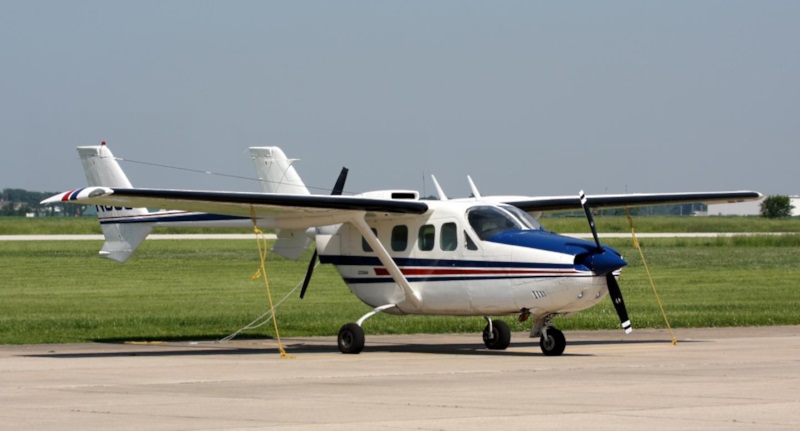
Powerplants were fuel-injected Continental IO-360-C air-cooled flat-six piston engines with 155 kW (210 HP) each, driving two-bladed variable-pitch props. There was a fuel tank in each outer wing, with a total usable capacity of 484 liters (128 gallons); an auxiliary tank could be fitted in each inner wing, to add a total of 136 liters (36 US gallons). There was a refueling point on top of each wing.
All gear had single wheels, the nose wheel being steerable and retracting forward, the main gear tucking back and up into the rear of the fuselage pod. There were two bucket seats up front and a bench seat in the rear, with a baggage hold behind the rear seats -- it appears that later variants may have had a loading door on the right. Other configurations, such as four bucket seats or six seats, were also available, though six seats appear to have been unusual. There was a front-hinged door on the right side -- no door on the left. A fiberglass belly cargo pannier was introduced somewhere along the line, with a capacity of up to 135 kilograms (300 pounds). The pannier was really a necessity with six seats, since there was no cargo hold in the rear in that configuration.
_____________________________________________________________________
CESSNA MODEL 337D SUPER SKYMASTER:
_____________________________________________________________________
wingspan:
11.58 meters (38 feet)
wing area:
18.7 sq_meters (201 sq_feet)
length:
9.07 meters (29 feet 9 inches)
height:
2.84 meters (9 feet 4 inches)
empty weight:
1,205 kilograms (2,655 pounds)
max take-off weight:
2,000 kilograms (4,400 pounds)
maximum speed:
320 KPH (200 MPH / 175 KT)
cruise speed:
150 KPH (145 MPH / 125 KT)
take-off run (relative to 15 meters / 50 feet):
470 meters (1,545 feet)
landing run (relative to 15 meters / 50 feet):
505 meters (1,650 feet)
service ceiling:
5,945 meters (19,500 feet)
range:
1,555 kilometers (965 miles / 839 NMI)
_____________________________________________________________________
The twin engines allowed the Model 337 to carry four passengers and adequate baggage, which had been somewhat problematic on the single-engine Cessna 172, though it also had four seats. The resonance of the two engines gave it a peculiar sound. Due to the "push-pull" configuration, the Skymaster's engine-out handling was benign -- though the noise levels were high. The baseline Model 337 was followed by improved variants:
The US Air Force obtained the Skymaster from 1967 as the "O-2A", Cessna calling it the "Model 337M" -- the major differences being military radios, additional glazing on the bottom of the door and forward of it to improve the view, and two stores pylons under each wing. It was introduced to service in 1967, with the type seeing considerable action in Vietnam. It typically carried two seven-round 70-millimeter unguided rocket pods, the rockets being fitted with smoke warheads to mark targets.

The USAF obtained 501 O-2As, with 12 obtained by Iran. The USAF also obtained 31 "O-2B" machines, which were civilian Skymasters, bought new, kitted up for the psychological warfare role, with three directional speakers and a leaflet dispenser. They were called "bullshit bombers", suggesting the propaganda role was held in low esteem. The O-2s lingered in military service to the early 1980s, with some retired from military service passed on to the California Department of Forestry. The CDF O-2s served as fire spotters into the early 1990s, to then be replaced by military-surplus Rockwell OV-10 Broncos.
The USAF considered a further militarized derivative of the Skymaster with turboprop powerplants, to be designated the "O-2TT", with tandem seating, a "bugeye" cockpit like that of the OV-10 Bronco, and a wider-span wing -- extended to 13.11 meters (43 feet) -- featuring lift-enhancement devices. A Skymaster was converted to a demonstrator, designated the "O-2T", with the new wing and twin Allison 250-B15 turboprops, providing 235 kW (315 HP) each. The Air Force decided not to proceed further, and the O-2TT would never go beyond full-scale mockup.
Reims of France, which did European production of many Cessna aircraft, also built the Skymaster. Reims production included:
In 1967, Cessna also flew a single cut-down "Model 327 Baby Skymaster", which most visibly differed from the Model 337 in having cantilever wings, without strut bracing. It didn't go into production, but it was flown by the US National Aeronautics & Space Administration (NASA) for aeronautical research on noise reduction and ducted propellers.
Total number of Skymasters, of all variants, produced up to end of manufacture in 1982 was about 3,000 machines -- only about 5% of them built by Reims. Government / military operators of the Skymaster, besides the US and Rhodesia / Zimbabwe, included Bangladesh, Burkina Faso, Chad, Chile, Colombia, Ecuador, El Salvador, Equatorial Guinea, Guinea-Bissau, Haiti, Honduras, Jamaica, Mexico, Mozambique, Namibia, Nicaragua, Niger, Portugal, Senegal, Sri Lanka, Thailand, and Togo. Haiti, Honduras, Nicaragua, Senegal, and Thailand were users of "Summit Sentry" militarized modifications of Cessna 337s with four stores pylons, the modification performed by Summit Corporation of the USA. There were also a number of unusual modifications of Skymasters:
Skymasters are still flying, some having been upgraded with new avionics, short take-off enhancements, and improved engines. There have been more turboprop conversions, generally with one engine, either in front or back, with the rear or front fuselage stretched accordingly. The US Navy operates a single O-2A with a turboprop in the rear and the front engine replaced by an extended nose with a sensor turret underneath. The "Pelican" is primarily used as a training aircraft, being used as a substitute for a drone in areas where the Federal Aviation Administration restricts drone flights. It seems the Pelican is "optionally piloted".
BACK_TO_TOP* The Cessna 310, having proven so successful, inspired Cessna to build a scaled-up follow-on, with initial flight of the "Cessna 411" on 18 July 1962. It was certified in 1964, with customer deliveries following.
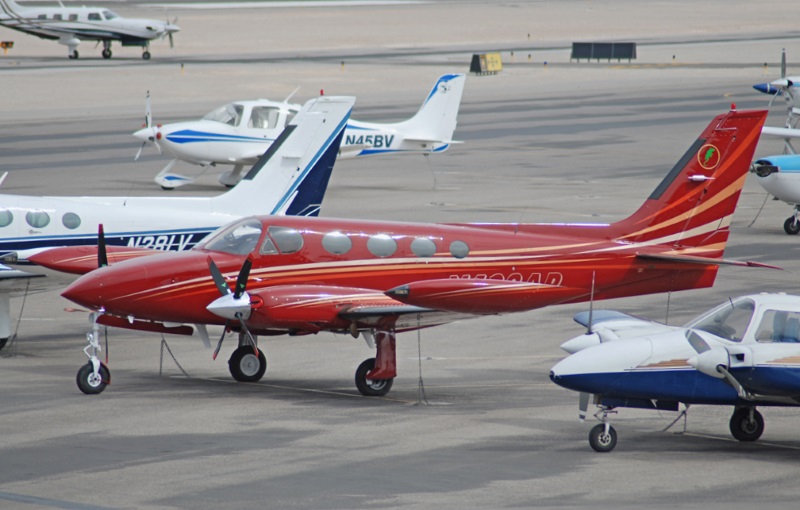
The Cessna 411 was effectively a Cessna 310 with a new fuselage. The two aircraft were a bit hard to tell from each other, with the flight surface configuration being effectively identical:
The landing gear all had single wheels, the main gear pivoting in the wings toward the fuselage, the nose gear retracting backwards. The Model 411 was powered by Continental GTSIO-520-C flat-six engines -- with reduction gearing (G), turbocharging (TS), and fuel injection (I) -- providing 255 kW (340 HP) each, driving three-bladed propellers. That was 18% more than the IO-520 engines of the Model 310, with 215 kW (285 HP) each.
_____________________________________________________________________
CESSNA MODEL 411:
_____________________________________________________________________
wingspan:
12.15 meters (39 feet 10 inches)
wing area:
18.58 sq_meters (200 sq_feet)
length:
10.2 meters (33 feet 6 inches)
height:
3.52 meters (11 feet 6 inches)
empty weight:
1,735 kilograms (3,820 pounds)
max take-off weight:
2,950 kilograms (6,500 pounds)
maximum speed:
430 KPH (270 MPH / 235 KT)
cruise speed:
360 KPH (225 MPH / 195 KT)
service ceiling:
7,925 meters (26,000 feet)
range:
2,090 kilometers (1,300 miles / 1,130 NMI)
_____________________________________________________________________
The Model 411 had oval passenger windows on each side of the fuselage, instead of the rectangular windows of the Cessna 310 -- indeed, although the 411 was unpressurized, it was more reminiscent of the pressurized Model 340 derivative of the Model 310. Like the Model 340, there were three large windows and one small window, the small window in the rear. Unlike the Model 340, it had a split airstair door, with airstairs on the bottom half, and a center aisle with seats on each side. It also had an emergency exit in a window over the right wing. Typical accommodations were four passenger seats in club configuration, plus two cockpit seats -- though two more passenger seats could be squeezed in if desired, for six passenger seats. There was a baggage hold in the rear of the passenger compartment, in the nose, and in the rear of each engine nacelle.
A total of 252 Cessna 411s was built to 1967, with 50 more "Model 411A" machines built over the next year, to end of production in 1968. The Model 411A was a tweaky modification, the only visible difference between a rounded nose, instead of the "pointy" nose of the baseline Model 411. It appears the rounded nose was slightly longer, adding about 8 centimeters (3 inches) to the length. It also had optional auxiliary fuel tanks -- one in each wing and one in each engine nacelle, each with a capacity of 76 liters (20 US gallons). All the tanks had their own refueling points; fuel management was said to be tricky, though not intolerably so. It seems the only government operator of the Model 411 was France, which obtained six Model 411As from 1966.
* The Model 411 led to a pressurized version, with the first flight of the "Model 421" on 14 October 1965, and introduction to service in 1967. It looked just like the baseline Model 411, except that it had a clearly bigger tailfin -- engine-out handling in the Cessna 411 had proven troublesome. It was powered by more powerful Continental GTSIO-520-D engines with 280 kW (375 HP) each, and had an MTOW of 3,085 kilograms (6,800 pounds).

A minor update, the "Model 421A", was introduced in 1969, this variant having a fuselage stretch of 7.6 centimeters (3 inches) -- increasing length from 10.2 meters to 10.3 meters (33 feet 6 inches to 33 feet 9 inches) -- to provide more cabin space. It also had 19 liters (5 US gallons) more fuel capacity, and a modest increase in MTOW.
A much more significant update, the "Model 421B", was introduced in 1971. It featured a 40-centimeter (16-inch) increase in wingspan to raise the flight ceiling, with wingspan increased from 12.15 to 12.55 meters (39 feet 10 inches to 41 feet 2 inches). It also had:
From 1975, an option was available to add de-icing gear. The Cessna 421B was sold as the "Golden Eagle", with passenger seating; and the "Executive Commuter", with a quick-change interior for passenger or cargo haulage. Passenger capacity remained as with the Model 411, meaning 4 or 6 seats. Cessna also offered a "II" option, with improved avionics, and a "III" option, with still further improved avionics, for the Model 421. The same options would be available for other Series-400 machines, but it seems they didn't apply to all of them.
_____________________________________________________________________
CESSNA MODEL 421C:
_____________________________________________________________________
wingspan:
12.53 meters (41 feet 2 inches)
wing area:
19.97 sq_meters (215 sq_feet)
length:
11.09 meters (36 feet 9 inches)
height:
3.49 meters (11 feet 5 inches)
empty weight:
2,040 kilograms (4,500 pounds)
max take-off weight:
3,380 kilograms (7,450 pounds)
maximum speed:
475 KPH (295 MPH / 255 KT)
cruise speed:
445 KPH (275 MPH / 240 KT)
service ceiling:
9,205 meters (30,200 feet)
range:
1,710 kilometers (2,755 miles / 1,485 NMI)
_____________________________________________________________________
The "Model 421C" was introduced in 1976; it deleted the wingtip tanks, giving a slight decrease in wingspan, with the fuel stored wholly in the wings instead. It appears that this innovation greatly simplified fuel management. Normal usable fuel capacity was 780 liters (206 US gallons), going up to 991 liters (262 US gallons) with engine nacelle locker fuel tanks. In 1981, the Cessna 421C also traded the original straight-leg main landing gear for "trailing-link" landing gear, a lever-arm scheme that gave softer landings. The Model 421C was sold as the Golden Eagle, but apparently not the Executive Commuter.
Production of the Cessna 421 ended in 1981, after 1,901 machines had been built. The Cessna 421 flew in government / military service with Bolivia, Cambodia, Ivory Coast, New Zealand, Pakistan, Turkey, and Zimbabwe, it appears mostly or entirely in the utility / VIP transport role.
* Cessna's work on the pressurized Model 421 was paralleled by work on a new unpressurized derivative of the Model 411, with the initial flight of the "Model 402" on 26 August 1965. The effort was focused on a utility aircraft that was economical to operate, with no emphasis on performance. It was introduced to service in 1967, with a "Model 401" variant introduced in parallel.
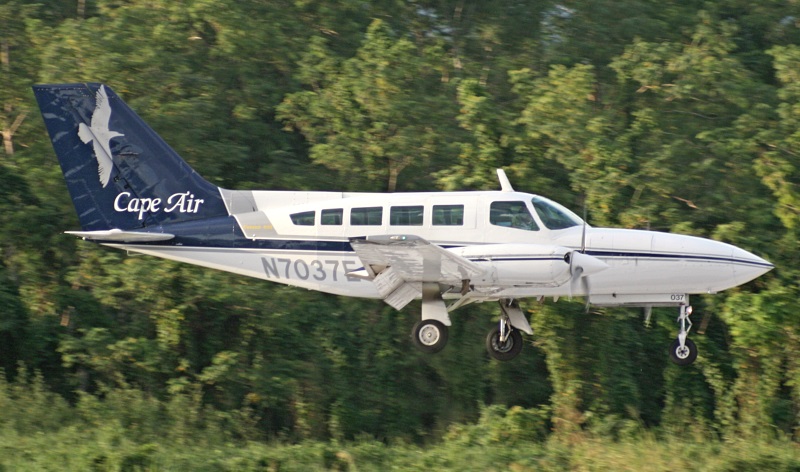
The Cessna 402 had a general arrangement like that of the Cessna 411, the two being hard to tell apart, other than the Model 402 having the larger tailfin. The only really major difference was that the 402 was powered by ungeared Continental TSIO-520-VB flat-six engines, with 240 kW (325 HP) each, driving three-bladed variable-pitch props. The 402 also featured simplified basic kit to reduce cost. It seated 4 to 8 passengers, with the seats being easily removeable for cargo hauling. There was a back-hinged passenger door on the rear left fuselage, with an optional larger forward-hinged cargo door in front of it.
The Cessna 401 was generally identical, except that it was configured as a dedicated executive aircraft with 4 or 6 passenger seats. A "Model 402A", with the big nose of the Model 421B, and an optional crew entry door, was introduced in 1969; length was extended from 10.2 meters (33 feet 9 inches) to 11 meters (36 feet 1 inch). There was also a "Model 401A" with minor tweaks, but keeping the original nose. A "402B" was introduced in 1970, the primary change being more fuel capacity, a total of 607 liters (184 US gallons). At that time, the Model 401 was discontinued, with the quick-change version of the Model 402B sold as the "Utiliner", and the executive-configured version sold as the "Businessliner". It appears that the elimination of the Model 401 was simply a product-line simplification that didn't change the status quo.
There were further tweaks to the Model 402B through the 1970s, most visibly changing the four oval windows on each side to five rectangular windows. Other changes included a simpler exhaust system, de-icing gear, plus an optional fire extinguisher or toilet.
The "Model 402C" was introduced in 1979, with wider-span wings without wingtip tanks. They weren't the same as those of the Model 421C, however, having a span of 13.45 meters (44 feet 2 inches), well wider than the Cessna 421C's wingspan of 12.53 meters (41 2 inches). The Model 402C also featured landing gear with a wider track, hydraulic actuation replacing electrical actuation, this change being carried on in the Series-400 line; TSIO-520-VB engines with 240 kW (325 HP) each; usable fuel capacity increased to 780 liters (206 US gallons); and greater MTOW.
Production of the Cessna 402 ended in 1985, a total of 1,535 Model 402s and 401 Cessna 401s having been sold. Government / military users included Barbados, Bolivia, Colombia, Comoros, Finland, Haiti, Malaysia, Mexico, Portugal, and Venezuela.
_____________________________________________________________________
CESSNA MODEL 402C:
_____________________________________________________________________
wingspan:
13.45 meters (44 feet 2 inches)
wing area:
21 sq_meters (225.8 sq_feet)
length:
11.09 meters (36 feet 5 inches)
height:
3.49 meters (11 feet 6 inches)
empty weight:
1,845 kilograms (4,069 pounds)
max take-off weight:
3,105 kilograms (6,850 pounds)
maximum speed:
425 KPH (265 MPH / 230 KT)
cruise speed:
445 KPH (275 MPH / 240 KT)
service ceiling:
8,200 meters (26,900 feet)
range:
2,360 kilometers (1,465 miles / 1,275 NMI)
_____________________________________________________________________
* In the 1970s, Cessna decided to rethink the Model 402, with the prototype of the unpressurized "Model 404" flying on 26 February 1975, and introduction to service in 1976. The Cessna 404 was generally similar to the Cessna 402C, the visible differences being a still larger tailfin, as well as a tailplane with noticeable dihedral. Somewhat less noticeably but more significantly, it was also almost a meter longer -- length being stretched from 11.09 to 12.05 meters (36 feet 9 inches to 39 feet 6 inches) -- with a comparable increase in cabin length; it accordingly had six rectangular passenger windows, instead of five.
The Model 404 was powered by geared Continental GTSIO-520 engines with 280 kW (375 HP) each. It had a usable fuel capacity of 1,287 liters (340 US gallons) in integral wing tanks. It also featured trailing-link landing gear on all gear assemblies.

The Model 404 ended up being sold as the "Titan", the model number being disregarded in marketing literature. At the outset, Cessna offered the Model 404 as the "Titan Ambassador", with 8 passenger seats, and the "Titan Courier", which was a quick-change passenger-freight version with 6 or 8 seats. Later a dedicated "Titan Freighter" was introduced, featuring a polycarbonate-lined cabin with cargo-handing kit, and the cargo door optional. Two Model 404s were obtained by the US Navy, being designated "C-28 Titan". Other government / military operators included Bahamas, Bolivia, Colombia, Dominican Republic, Hong Kong, Mexico, Sweden, Tanzania, United States, and Puerto Rico.
_____________________________________________________________________
CESSNA MODEL 404 AMBASSADOR I:
_____________________________________________________________________
wingspan:
14.23 meters (46 feet 8 inches)
wing area:
22.48 sq_meters (242 sq_feet)
length:
12.05 meters (39 feet 6 inches)
height:
4.04 meters (13 feet 3 inches)
empty weight:
2,185 kilograms (4,815 pounds)
max take-off weight:
3,810 kilograms (8,400 pounds)
maximum speed:
430 KPH (265 MPH / 230 KT)
cruise speed:
300 KPH (190 MPH / 165 KT)
take-off run (relative to 15 meters / 50 feet):
720 meters (2,365 feet)
landing run (relative to 15 meters / 50 feet):
650 meters (2,130 feet)
service ceiling:
7,900 meters (26,000 feet)
range:
3,410 kilometers (2,115 miles / 1,840 NMI)
_____________________________________________________________________
BACK_TO_TOP
* Following the introduction of the Model 402 and Model 421, Cessna came up with a hybrid, the "Model 414", with first flight of a prototype on 1 November 1968, and introduction to service in that year. The Model 414 was a pressurized Model 421 fuselage mated to the flight surfaces of the Model 402, being powered by ungeared Continental TSIO-520-J engines. Usable fuel capacity was 808 liters (213 US gallons).

From 1976, the Model 414 acquired the name of "Chancellor". In 1978, an improved "Model 414A" was introduced, featuring the wide-span wings with no tip tanks -- plus the big nose -- of the Model 402C, and TSIO-520-N engines with 230 kW (310 HP) each. A total of 1,070 Model 414s was built to end of production in 1985. The only government / military operators were the Bahamas and Lebanon, presumably for executive / utility use.
_____________________________________________________________________
CESSNA MODEL 414A CHANCELLOR:
_____________________________________________________________________
wingspan:
13.45 meters (44 feet 2 inches)
wing area:
21 sq_meters (225.8 sq_feet)
length:
11.09 meters (36 feet 5 inches)
height:
3.49 meters (11 feet 6 inches)
empty weight:
1,980 kilograms (4,365 pounds)
max take-off weight:
3,060 kilograms (6,750 pounds)
maximum speed:
435 KPH (270 MPH / 235 KT)
cruise speed:
445 KPH (275 MPH / 240 KT)
service ceiling:
9,400 meters (30,800 feet)
range:
2,460 kilometers (1,530 miles / 1,330 NMI)
_____________________________________________________________________
* The first turboprop-powered member of the Cessna 400 series was the "Model 441", which performed its initial flight on 10 January 1977, with introduction to service later that year.
It was derived from the Cessna 404, with a revised fuselage and extra-wide-span wings, extended in span by wingtip extensions -- increasing span from 13.45 meters to 15.04 meters (44 feet 2 inches to 49 feet 4 inches). It originally was to be powered by Continental engines, with the designation of "Model 435" -- but the decision was made to use turboprops instead. It was powered by Garrett TPE331-8-403S turboprops with 475 kW (636 SHP) each driving three-bladed Hartzell variable-pitch propellers. Usable fuel capacity was 1,798 liters (475 US gallons).
The Cessna 441 was pressurized; instead of the rectangular windows of the Model 404, the windows were tablet-shaped, with rounded corners, providing a distinctive recognition feature. It still had six passenger windows, like the Model 404. Passenger seating ranged from 4, in an executive configuration, to a maximum of 10.

The Cessna 441 was grounded in 1978, following a fatal crash, with aircraft in service then updated with a new tail assembly. In 1983, the Model 441 was given the name of "Conquest II" -- see below for an explanation of what the "Conquest I" was. This was a somewhat confusing designation, since it clashed with the "II" avionics option designation that applied to some of the other Series-400 variants.
The next year, 1984, production switched to four-bladed McCauley propellers. In 1986, one was fitted with Pratt & Whitney Canada (PWC) PT6A-112 turboprops as an experiment, but it did not enter production. A total of 362 Model 441s was built to end of production in 1987.
_____________________________________________________________________
CESSNA MODEL 441 CONQUEST II:
_____________________________________________________________________
wingspan:
15.04 meters (49 feet 4 inches)
wing area:
23.56 sq_meters (253.6 sq_feet)
length:
11.89 meters (39 feet)
height:
4.01 meters (13 feet 2 inches)
empty weight:
2,245 kilograms (6,257 pounds)
max take-off weight:
3,900 kilograms (10,165 pounds)
maximum speed:
550 KPH (340 MPH / 295 KT)
cruise speed:
480 KPH (300 MPH / 260 KT)
service ceiling:
11,000 meters (35,000 feet)
range:
4,065 kilometers (2,525 miles / 2,195 NMI)
_____________________________________________________________________
* Following the Cessna 441, Cessna then developed a turboprop-powered version of the Model 421C, with initial flight of the "Model 425 Corsair" on 12 September 1978, and introduction to service in 1980. It was powered by two PWC PT6A-112 turboprops with 375 skW (500 SHP) each, driving three-bladed Hartzell variable-pitch propellers, on long-span wings like those of the Model 414. There were fuel tanks in the outer wing, inner wing, and engine nacelles, with a refueling point in each engine nacelle, and total usable fuel capacity of 1,385 liters (366 US gallons). The Model 425 had the dihedral tailplane of the Model 404.
_____________________________________________________________________
CESSNA MODEL 425:
_____________________________________________________________________
wingspan:
13.45 meters (44 feet 2 inches)
wing area:
20.9 sq_meters (225 sq_feet)
length:
10.9 meters (35 feet 10 inches)
height:
3.84 meters (12 feet 7 inches)
empty weight:
2,230 kilograms (4,915 pounds)
max take-off weight:
3,900 kilograms (8,600 pounds)
maximum speed:
500 KPH (310 MPH / 265 KT)
cruise speed:
300 KPH (190 MPH / 165 KT)
take-off distance (relative to 15 meters / 50 feet):
855 meters (2,800 feet)
landing distance (relative to 15 meters / 50 feet):
755 meters (2,480 feet)
service ceiling:
10,180 meters (33,400 feet)
range:
2,480 kilometers (1,540 miles / 1,340 NMI)
_____________________________________________________________________
Prop de-icing, electrical / alcohol windscreen de-icing was optional; a weather radar was optional as well. Passenger capacity was from four to six seats. Accommodations were climate-controlled and air-conditioned.
The Model 425 was well-received, having the good handling generally noted for Cessna aircraft, as well as a comfortable cabin with large windows. The type was then upgraded with a revised cabin and greater MTOW, with this improved variant known as the "Conquest I" -- with the Model 441 given the name of "Conquest II" as a complement. Early-production machines could be upgraded to Conquest I standard.
The Conquest I / Cessna 425 and Conquest II / Cessna 441 were similar enough to be a bit hard to tell apart. The most visible distinction was that the Conquest I had five oval windows on each side, like the Model 421C, while the Conquest II had six tablet-style windows. The Conquest II was also a meter longer than the Conquest I. 236 Cessna 425s were built up to end of production in 1986.
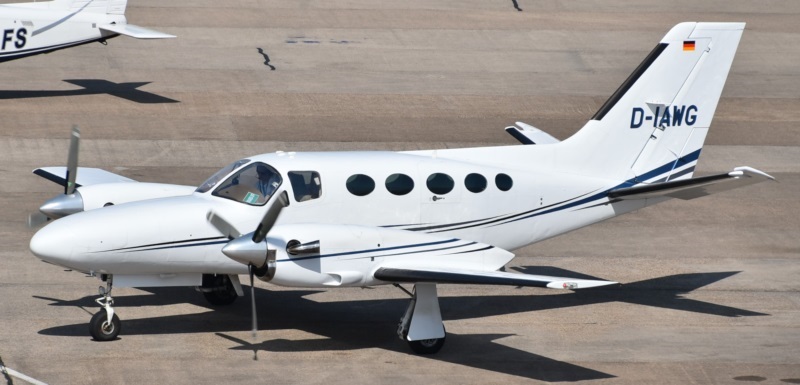
* Many of the Cessna 400-series twins are still flying today, with upgrades available -- such as glass-cockpit avionics; updated interiors; winglets; and updated engines, for example Lycoming flat-sixes or PWC PT6A turboprops. Turboprop conversions of the Cessna 421 bringing them up to "near-Cessna 425" standard.
There have also been some "special-mission aircraft (SMA)" configurations in the series, though the 400-series is hardly in a league with the Beech King Air in that regard. The UK Coastguard acquired a Cessna 404 for pollution patrol and fitted it with a side-looking radar in a plank-style antenna under the fuselage, with that particular aircraft replaced by one with a much more extensive sensor suite.
The UK's Ordnance Survey, the national mapping authority also flies a Cessna 402 and a 404 for mapping Britain. These machines are fitted with a high-resolution digital camera, and carry a laptop computer for operating the camera and recording its imagery in mass storage. There are also mentions of Cessna 414s and 441s kitted out for aerial survey, though details are lacking.
BACK_TO_TOP* The Cessna 400-series is confusing to document. All of the variants are descendants of the Model 411, which began life as a derivative of the Model 310 in turn, with successive variants undergoing different modifications. The numbering sequence of the Series-400 variants is not intuitive, and the fact that there were parallel paths of variant development makes their history even more difficult to trace.
To add to the complexity, Reims of France built their own PT6A-powered derivative of the Model 404, the "Model F406", with initial flight of the prototype on 22 September 1983. Deliveries were from 1985. To generate even more confusion, the F406 was named the "Caravan II" -- the name being a marketing gimmick, the machine having nothing much in common with the single-engine Cessna Caravan except the PT6A engine. Incidentally, the only Cessna twins built by Reims were the Skymaster and the F406.
The Reims F406 was the unpressurized Cessna 404 fuselage mated to the extra-long wings of the Cessna 441, with PT6A engines. The F406 also had the landing gear and longer, rounded nose of the Model 441, instead of the pointy nose of the Model 404. Just like the Model 404, the F406 had seven rectangle-style windows on each side and the dihedral tail, making it easy to confuse with the Model 404, the most visible difference being the turboprop engines. It also distinctively acquired twin ventral strakes under the tail, being the only Series-400 machine with such a feature.
The F406 was originally powered by PT6A-112 engines, with 375 kW (500 HP) each. There was a fuel tank in each wing, total usable capacity being 1,798 liters (475 US gallons).
_____________________________________________________________________
REIMS-CESSNA MODEL F406:
_____________________________________________________________________
wingspan:
15.09 meters (49 feet 6 inches)
wing area:
23.48 sq_meters (253 sq_feet)
length:
11.89 meters (39 feet)
height:
4.01 meters (13 feet 2 inches)
empty weight:
2,285 kilograms (5,035 pounds)
max take-off weight:
4,245 kilograms (9,360 pounds)
maximum speed:
430 KPH (265 MPH / 230 KT)
cruise speed:
260 KPH (160 MPH / 140 KT)
take-off run (relative to 15 meters / 50 feet):
805 meters (2,635 feet)
landing run (relative to 15 meters / 50 feet):
675 meters (2,210 feet)
service ceiling:
9,145 meters (30,000 feet)
range:
2,135 kilometers (1,325 miles / 1,153 NMI)
_____________________________________________________________________
As with the Model 404, there was a split airstair door on the left rear fuselage, with an optional front-hinged cargo door in front of it. There was an emergency exit over each wing, instead of just on the right as with the Model 404. The Reims F406 could be configured as:
While the other Series-400 machines were only infrequently used as SMA platforms, the F406 was heavily promoted in the SMA role. That was very likely the reason it was called the "Caravan II" -- leveraging off the single-engine Caravan's use as a utility workhorse, not an executive aircraft. Special mission configurations included:
SurMar and PolMar configurations had a mission-management system. In a typical special-mission configuration, the crew would be one or two pilots, a systems operator, and possibly an observer. Reims offered underwing stores attachments for the SMA, stores capability including weapons and munitions -- but it is unclear if anyone obtained Model F406s with them.
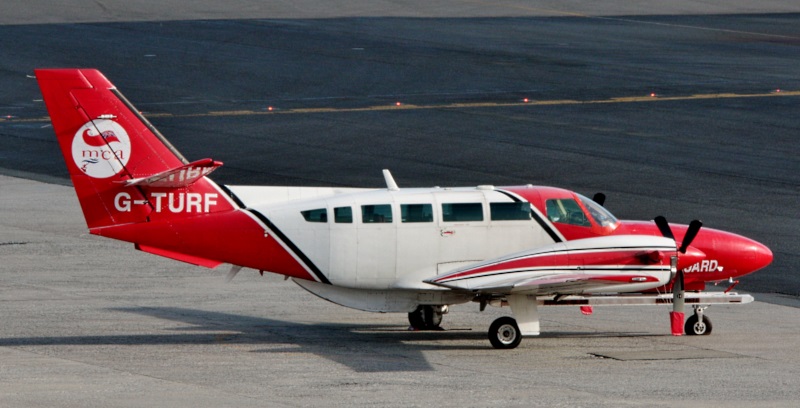
An "F406 Mark II" was introduced in 2000, the primary change being PT6A-135A engines with 475 kW (635 SHP) each, driving four-bladed propellers. It also had an updated, reduced-weight airframe; new glass cockpit; updated cabin interior options; and MTOW increased 4,700 kilograms (10,360 pounds).
99 Reims F406s were built up to 2013, when the firm went broke. Most remain in service. Special-mission F406s were obtained by Australian and Greek coast guards; Scottish Fisheries; and British, French and US customs. British police fly two of them with a litter of antennas, these mysterious machines said to be used for eavesdropping on cellphone calls.
In 2014, rights to the Model 406 were acquired by Continental Motors -- now an arm of the Aviation Industry Corporation of China (AVIC) -- and ASI Innovation of France. The joint venture is named ASI Aviation; the plan is to build the Model 406 in Mobile, Alabama, offering piston or even diesel engines as alternative powerplants. However, little has been said of the matter since then.
* It is useful to list the various Series-400 machines to help sort them out:
* Cessna generally lost interest in prop twins towards the end of the 20th century, preferring to focus on the company's Citation line of twinjet business jets. The firm also made a big hit out of its Caravan single-engine turboprop utility aircraft. In the 21st century, Cessna has returned to twin-prop aircraft, using the Caravan as the starting point, developing the twin-turboprop Cessna "Model 408 SkyCourier" utility aircraft. Federal Express, an enthusiastic user of the Caravan, has up to 100 SkyCouriers on order.
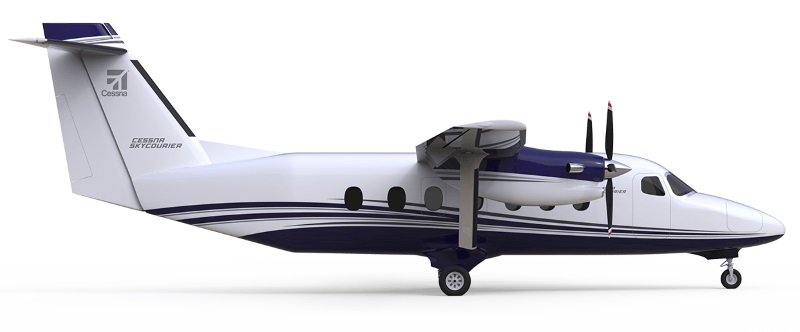
As introduced, the SkyCourier had a high-mounted rectangular braced wing, tricycle fixed landing gear, with an emphasis on utility and sturdiness. Its roots in the Caravan were generally conceptual; it looked more like the classic Twin Otter twin-turboprop utility aircraft, and had little parts commonality with the Caravan. The SkyCourier was powered by Pratt & Whitney Canada PT6A-65 turboprops providing 820 kW (1,100 SHP) each, driving McCauley four-bladed aluminum props. It had single-point refueling; it was unpressurized, and had a Garmin G1000 avionics suite.
_____________________________________________________________________
CESSNA 408 SKYCOURIER:
_____________________________________________________________________
wingspan:
21.95 meters (72 feet)
length:
16.71 meters (54 feet 10 inches)
height:
6.02 meters (19 feet 9 inches)
cruise speed:
370 KPH (230 MPH / 200 KT)
take-off run:
1,000 meters (3,300 feet)
service ceiling:
7,600 meters (25,000 feet)
range, laden:
740 kilometers (460 miles / 400 NMI)
_____________________________________________________________________
Maximum payload was 2,720 kilograms (6,000 pounds); freighter versions could haul three standard LD3 cargo containers, loaded through a large freight door on the rear left fuselage. Passenger liner versions had 19 passenger seats, along with large cabin windows. Combi configurations were on offer, and Cessna is considering special-mission versions as well. First flight of the first of two SkyCourier air prototypes was on 17 May 2020; three ground-test prototypes were built as well. Deliveries to FedEx started in 2022. The US government has foreign military sales (FMS) lined up.
BACK_TO_TOP* When I was in the US Army and stationed at Fort Hood, Texas, in 1973-1974, I used to see Air Force 0-2 Skymasters on occasion while I was out on field exercises. They'd orbit over an operational area, and then a strike aircraft -- usually a Vought A-7D -- would come roaring in.
* Much of this document was derived from the online Wikipedia, with references to various volumes of JANE'S ALL THE WORLD'S AIRCRAFT, as well as articles from the Cessna Flyer's Association and the AOPA. General aviation aircraft are rarely over-documented.
* Illustrations details:
Revision history:
v1.0.0 / 01 feb 19 v2.0.0 / 01 may 19 / Generally rewrote & updated, added F406. v2.0.1 / 01 mar 21 / Review, update, & polish. v2.0.2 / 01 mar 22 / Review, update, & polish. v2.0.3 / 01 feb 24 / Review, update, & polish. (+)BACK_TO_TOP
